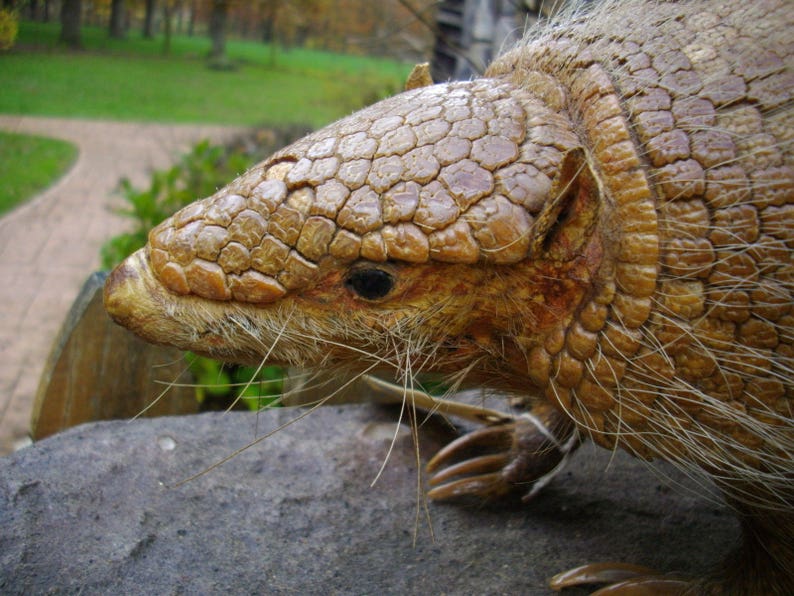

The isolated population on the coast of Buenos Aires Province, Argentina, is negatively affected by mining activities. The species also suffers from habitat loss from sand excavation for concrete production and agricultural activities. In addition, some individuals are killed by hunting dogs and by cars on roads. It is also persecuted as an agricultural pest. The carapace is particularly sought for making charangos, a South American musical instrument akin to a lute.The screaming hairy armadillo is heavily hunted for its meat and carapace (including for charangos, a musical instrument, and matracas or maracas), in Bolivia in some parts of the Chaco region. The disjunct population of coastal Buenos Aires Province, Argentina, is adversely affected by mining activities. It is at times considered an agricultural pest and killed by hunting dogs. This armadillo is heavily hunted for its meat in parts of the Chaco region in Bolivia. The armadillos become sexually mature at nine months and produce two litters per year. The gestation period of the armadillo is 60–75 days. This armadillo ingests a lot of sand while feeding, and it may occupy as much as 50 percent of the volume of its stomach at a time. Vertebrates form a significant part of an armadillo’s diet, ranging from 27.7 percent by volume in summer to 13.9 percent in winter, the most common prey species being lizards, birds, frogs, and the mice species Eligmodontia typus and Phyllotis griseofulvus. The animals increase their weight by up to 10 percent in winter, forming a layer of subcutaneous fat 1 to 2 cm (0.39 to 0.79 in) thick. The armadillo is omnivorous its diet consists of insects, vertebrates and plant material (especially pods of Prosopis), varying considerably depending upon the season. When not in its burrow, the animal spends most of its time foraging. The animal does not build a nest in its burrow which it seals during occupation. The home range of an armadillo is recorded to consist of a minimum area of 3.4 ha (8.4 acres). A burrow may be eight to 15 in (200 to 380 mm) in diameter and may be several metres long.

It has multiple burrows in its range, and each burrow may have more than one entrance. It often burrows at the base of bushes and shrubs. It can subsist for long periods without water. The armadillo is nocturnal by summer and diurnal in winter. The average annual rainfall in its main range is 200 to 600 mm (7.9 to 23.6 in), while the rainfall averages 1,000 mm (39 in) annually in the area of the Buenos Aires population. Its natural habitats are subtropical or tropical dry forests, temperate shrubland, subtropical or tropical dry shrubland, temperate grassland, subtropical or tropical dry lowland grassland, hot deserts, temperate desert, arable land, pastureland, and plantations. It is absent in rocky areas where the armadillo would not be able to burrow. An isolated population is found in eastern Buenos Aires Province in Argentina. The screaming hairy armadillo is a burrowing armadillo of arid areas from low to high altitudes. It is found in parts of the Gran Chaco and Pampas areas of Argentina, Bolivia, and Paraguay. The hair on the dorsum is light brown in colour. The armadillo has 18 bands of which six to eight are movable bands. These armadillos have more hair growth than other armadillo species.

The male weighs between 543 to 1,329 grams (19.2 to 46.9 oz), with an average of 860 grams (30 oz), while the range of weight for the female is 257 to 1,126 grams (9.1 to 39.7 oz), with average weight as 814 grams (28.7 oz). The male armadillo has a length ranging from 328 to 400 mm (12.9 to 15.7 in) with an average length of 376 mm (14.8 in), while the length of the female ranges from 265 to 419 mm (10.4 to 16.5 in) with an average length of 368 mm (14.5 in). This is one of the smallest and most slender species of the genus Chaetophractus, but it has longer ears than others in its genus. Pannosus (Gardner, 2007)) although the taxonomic validity of the split has been called into question.

Two subspecies are currently recognized (C. Gray in 1865 from a specimen in the British Museum collected from Santa Cruz de la Sierra in eastern Bolivia as Dasypus vellerosus. The adjective “screaming” derives from its habit of squealing when handled or threatened. The screaming hairy armadillo is a species of armadillo also known as the small screaming armadillo, crying armadilloor or the small hairy armadillo. It is a burrowing armadillo found in the central and southern parts of South America. Interesting Creatures… Screaming hairy armadillo įeatures / Columnists, Interesting Creatures in Guyana


 0 kommentar(er)
0 kommentar(er)
